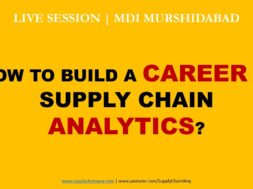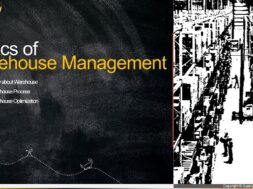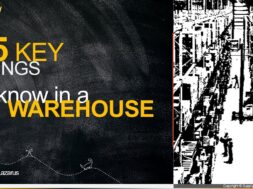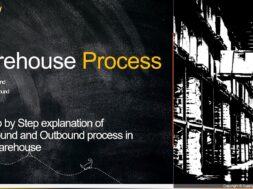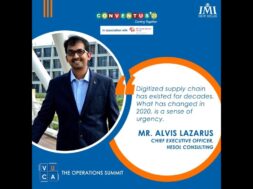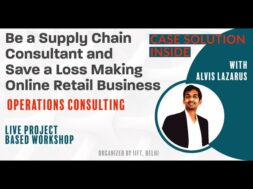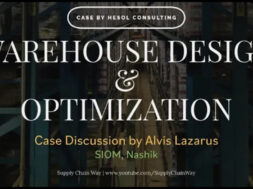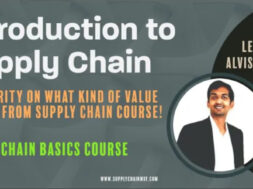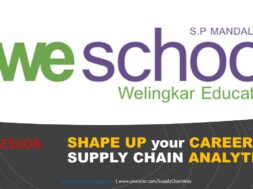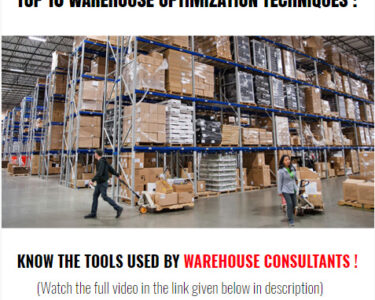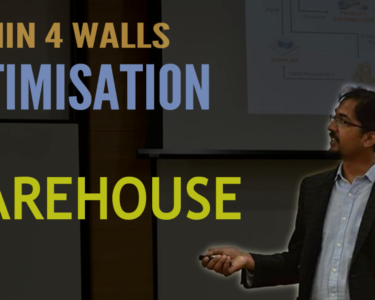MDI Murshidabad | Supply Chain Analytics Career Live Session by Alvis Lazarus
Hello everyone. I am Alvis Lazarus. I am a Supply Chain Consultant. In this session I will clarify your doubts about what you have. I am going to quickly give you a preview of something which is not there in the video lesson which you would have seen in the Supply Chain Way YouTube channel.
Let’s start with the market size of Supply Chain Analytics. In general let me put that as an Analytics as a global market is expected to reach around 16 to 20 billion US Dollars by end of 2024 and with the cagr of around 16 to 17%. In nutshell it tells this an analytics sector overall having a huge potential and it is going in the right direction. But if you see the summary in terms of how I ended the video session an Analytics has a great future but only Analytics doesn’t have a great future. That’s mean anyone who wants to see yourself in next 10 years into a cxo role kind of thing you need to acquire two additional skills, which are:
1. Your problem-solving ability
2. Managing a team
Other things in terms of as a career you can get into the individual contributor like a data-scientist, you can complete your PhD in this area you can have completely an individual contributor role, contributing towards research in research you build something new that is an option one or you can get into an Analytics part of operation itself. If you see all senior operations roles need an analytics as an additional skill set but that will never take as a front sheet, so you should be careful about that.
The third one you can also be a part of an organization which gives analytics as a service. You can think about all the product companies where they go, given that as a service even there is a split within that people who rely completely on analytics products, like how people sell ERP, they sell this product that is one way of seeing it. The other one is basically how Hesol does. We completely do problem solving, while solving it you use any of the technology or product available. Similar way for your analytics as a service as well.
The last one getting into roles like process excellent roles. So you can go do process transformation in the organization so you are seen as a sme but what you do is use your analytics ability to do data back decision-making. So this is the preview.
Question: After this pandemic there will be a huge role of technology in every field. So I want to know what role technology will play and in which domain, like Supply Chain warehouse, logistics etc. in which domain role of technology will be highest and in which will be lowest?
Answer: Let me put this way currently if you see where analytics stand post-COVID where it is being adopted most in terms of manufacturing, distribution and planning. But the adoption was very good in terms of penetration in the planning side of it. That is where all the predictive analytics were used. Post-COVID as you rightly said could you follow the market, there is a tremendous shift in this one. Recently I talked about Positive impact of COVID-19 that is that one digital transformation is going to be one of the biggest changes. Because now people realize that their Supply Chain was not to the mark and which is reflecting in terms of the number of projects which we are handling currently. It is actually increased multiple times what we used to do post COVID. And the sector is going to get the most positive impact most is the Global logistics. I restate that Global logistics is huge, without spending more time I will pick one number The Global e-commerce market is expected to reach around 6 Trillion in another two to three years. Out of it 1/4th of this market of the 6 Trillion US Dollar is going to come from cross-border selling. That means the beneficially is going to be the logistics. Because in e-commerce when you come with what else is that you need to take the product to the customer. So there the technology adoption is more in this Global logistics as an overall market. Very specifically if I need to tell you what kind of things will come as a follow-up question I will add to it. BlockChain is going to lead the way. Block Chain, IoT as well as Industry 4.0 these are the three things which will then as an umbrella then underneath there will be a lot of tools and methods everything aligned with it will actually spearhead this penetration of technology in Global Logistics.
Thank you.
Question: How important to study Supply Chain Analytics? If I know business analytics is it important to go and study or supply chain analytics is totally different?
Answer: If you talk about Supply Chain it covers right from your procuring raw material, conversion, storage, taking it to the customer, it covers end-to-end. So normally business analytics when someone listens to it they think it is on the finance side, it is on business that is absolutely not right. Even if you tell a Financial analyst If he has to do a good job he has to understand the nuances of Supply Chain otherwise he can’t even read any of those datasets.
So to answer your question: We will split it into two:-
1. Learning analytics what you learn in analytics is like how to make sense out of data. How to diagnose a data, how to present the data and from that how I can start predicting you make some model or assimilation whatever you do to start predicting and then you do a problem solving. This is the way I would have explained this in the video so this is what you do in analytics.
Now to use analytics in supply chain you should know Supply Chain functional knowledge. If you want to do the same analytics financially you should know the financial terms not just that you should also know the nuances of the sector where you are going to do this.
So in a nutshell what it tells you is Analytics is actually a tool which you learn it’s like a toolkit for you. But to become a problem solver along with that you should acquire the functional knowledge and I’ll tell you actually that gives you an edge as an analytician itself. And there is a only way you can go from your left to right on the Scam model which I have explained in the video even on the Gartner model which I have given. The Descriptive, Diagnostic, Predictive and Prescriptive.
Thank you.
There are few questions in the Chat box that I will take, but prior to that whoever is asking the question can go ahead. I will have a look at my chat.
Question: When I’ve been reading since the COVID that many service provider companies are shifting processes to their own country. For example, the USA. Because they can’t control their offices here when they’re operating in India. So I wanted to know after this pandemic what will be the impact in service operation, what is the growth in service prospect overall?
Answer: Whatever is happening currently in economics in terms of your Global trade War anyway that has a separate topic itself. Taking back operations and giving to other things no Vietnamese speaking up Malaysia and Philippines these are the countries becoming a managing pie all these tend to happen. But in terms of overall if you see as a services industry or contributions to the overall economy service has a huge pie. I’m talking about Indian economy. Now there is a great push towards manufacturing you know the reasons why. So I’m not going to spend more time on that. So the moment manufacturing is going to take a pie, you may think that service is not shrinking it won’t because the overall economy itself is growing, so I don’t see how temporary stagnation can happen. But post COVID situations you know what is happening.
More and more virtual works are happening. I am actually in Andhra Pradesh currently in a very remote place. I just took a few kilometers to drive on my car. People from this local area were sitting on their laptops and working, so I was so interested, I stopped one person and asked what are you doing. That person was doing an Erp Consulting and his client sits in the US. You know what that means: a completely different service model which to be very frank Hesol has been doing for the past 3 years the same way, the virtual working model. Because we work across 1819 cities. So we are very used to this virtual working model, so that is picking up you know what that means more and more the service industry is going to get boomed up and trust me, compare the rates between India unit our rate versus overseas countries take any other country. 100% your service business is going to increase unless there’s a specific law put in by the nation to protect their people in terms of you can’t outsource more than this. Those laws can change but if it’s the free economy definitely India is going to be a lead in terms of getting more and more service business.
Question : Is the Gartner model and Scam model told in the video are the basic methods to solve data analytics problems?
Answer: So what I would suggest is: Go to our YouTube channel which is youtube.com/supplychainway
The reason video is analytics video is that I’ve explained both the models the Gartner model and the Scam model. Scam model is basically in nutshell of my experience with an Analytics, please go through with that, you will get those answers what you have just asked here.
Question: Is it necessary to do white belt, yellow belt before going to Green belt?
Answer: Not necessarily. But I would suggest you do green belt or directly even black belt when there’s a requirement. I know most of the students are coming with Green belts. Are you going to use it unless you use it? You will forget it, so my suggestion is get into an industry in which kind of certification is needed please do that.
Question: Anytime we need to do analytics we need data but we don’t know how to gather those data. Is there any tool or something from which we can gather those data?
Answer: That is the role of a data architect. If you saw in the video I would have told one of the most underrated roles. But that role actually captures it, thinking about you running a project involving six different countries. And the biggest project I have run is involving 15 different countries which is an end-to-end Supply chain. Now the data architect we were working with in that project has only one shot at collecting data, because that involves so much of money or part of our budget almost 15 to 20% goes to data collection. If I miss it I need to spend another 15-20%. So to think about the role of a data architect, he is the person who has to insure that he’s collecting. So you need to come up with the measurement plan and you have to come up with the approach, you need to ensure multiple people are collecting, they should understand the right method of getting the data so you should have the validation techniques. It’s all a complete role of data architect. And then go to that a data analyst then to the business analyst. I think this explanation is there in the video. Just to save time with more questions I would suggest you to see the video again with this note you will get a better understanding.
Question: How do you deliver cross-functional projects and capacity and capacity to influence take-holders?
Answer: One is time management which is completely using the discipline of having a Gantt chart, a project plan for each and have time management tools for you that is a whole lot of productivity tools.
Cross-functional teams when you have to influence them think about me as a consultant, I go there to directly interact with the top guy in the organization. It could be a CXO role. And that person will tell Alvis, your team can solve this, now this is my team go improve the process. The first level which comes as a wall is the middle management. Because they won the process obviously there’s a reason for them to tell hey this is my process how an external person can do that. So as a consultant I don’t have three months to do ice breaking. I should do it in a few days. That is a skill you will acquire as a consultant how to get your team you’re going to work where you need to make the change. Make the part of your team work as a team to ensure you are not doing fault-finding because something’s in the company’s fault finding; you can just point fingers. In Consultant life you can’t do that you need to find the issues but you should not call them false you need to come up with a solution using the same team where you worked with to find issues to solve it. And the Cxo whom you’re working with won’t be happy with you if you’re not able to implement what you have done.
This is a tricky part of how to be a consultant. More on this I will explain in the next sessions which we are planning how to build a supply chain Consulting career I will talk more about this.
Question: Many times we do many kinds of certification and Six Sigma Green Belt is one of them, but most of the time we don’t know exactly when to apply those things. So give us some insights about that.
Answer: Assume me as a student. When I was in my student life, I went ahead and bought all the tools required by a car mechanic. So everything I bought in and then at the end of a student life I became a carpenter. What will happen? All those tools you have bought are waste. That’s the reason I always tell,
If you have the capability or you have already decided this is where I need to go I need to become a car mechanic at what may I will get into that only. Then to become a car mechanic what are the tools needed you will buy that.
Similar case with if you want to become a carpenter whatever tools needed you buy those tools you learn them you become a car mechanic you can use it. But if you’re not still clear in terms of whether I’m going to do this or do this. At that confusion I would suggest you not to use more and more tools. It is a crux of it.
Second thing at a student life sometimes you can learn all the different tools but the problem with these tools is unless you use it you will forget them, you may have to again do a refresher session before you get into your corporate life. I think that is the nutshell of what you need to do.
Question: What career Prospect can I look forward to if I take up marketing and Analytics as my career option?
Answer: Even to be a good marketer you need to use analytics, but only descriptive and diagnostic analytics. So you need to decide, you’ll be a great marketer with this analytics you can use this analytics for your campaigns you can understand your customers etc. No doubt about that. But if you decide to get into analytics as a prime career then all whatever you have learned in marketing won’t be good or won’t serve a purpose unless you become an analytician and work on the marketing function. That combination I don’t see much of scope. But if you want to get into a complete analytics career then you need to step up from descriptive, diagnostic and then you need to go to the next level you need to learn more and more methodologies and tools from analytics to make the career spearhead.
Question: How important is to integrate each unit of a business function taking it from the point of block chain?
Answer: Even with or without block chain, see Block-chain is more first between organizations that is where I see that will penetrate because their values are really high. The value prop what involved is very high. Then it can definitely integrate within the function. But again time back to the same question.
A technology won’t come and solve everything for you. Period I would say any day any time this is the answer. To fix the working at silos issue first you need to stabilize your organization and then bringing a block Chain or IoT or Industry 4.0, all the big names can come later. First Step the basic is align your functions not functional silos. Stabilize your process, this is a process transformation indirectly you are actually changing the culture in an organization and then you can go ahead whichever technology that’s matter most to you.
If you have any follow-up questions you can always use our Supply Chain forum. www.supplychainway.com/Forum. You can log your question, within 48 Hours you will get the answer from the Consultants. Please feel free to use the YouTube channel. YouTube channel completely I put a dedicated person for answering. Please make use of it as you know it’s a completely free channel.
Wish you all the best and I hope to see you in the next session which is on Supply chain consulting.
Thank you all.
